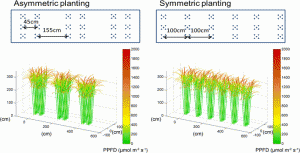DOI: 10.1007/s12155-017-9823-x
Development of a three-dimensional ray-tracing model of sugarcane canopy photosynthesis and its application in assessing impacts of varied row spacing
Abstract
 Sugarcane has emerged as the second largest source of biofuel, primarily as ethanol produced in Brazil. Dual row planting using asymmetric spacing of rows can decrease damage to plants and soil structure from harvest equipment though potentially can cause some loss of productivity due to increased shading. Can we assess this loss, without experimental testing of the thousands of potential permutations of planting design and cultivar canopy form? Here we develop a computational framework which couples 3D canopy architectural information, a ray-tracing algorithm, and a steady-state C4 photosynthesis model to study this question. We demonstrate the utility of the model by comparing evenly spaced rows at 100 cm to alternating row spacing of 45 and 155 cm. Asymmetric planting caused a 9% decrease in predicted net canopy carbon uptake over the growing season for a major current cultivar. The loss was greater at lower leaf area indices, when leaves were more vertical and when rows were oriented east-west, suggesting agronomic approaches to minimize loss. This study demonstrates the utility of this computational framework, which could also be used to aid breeding by identifying ideotypes for different environments and objectives, and to assess impacts of environmental change.
Sugarcane has emerged as the second largest source of biofuel, primarily as ethanol produced in Brazil. Dual row planting using asymmetric spacing of rows can decrease damage to plants and soil structure from harvest equipment though potentially can cause some loss of productivity due to increased shading. Can we assess this loss, without experimental testing of the thousands of potential permutations of planting design and cultivar canopy form? Here we develop a computational framework which couples 3D canopy architectural information, a ray-tracing algorithm, and a steady-state C4 photosynthesis model to study this question. We demonstrate the utility of the model by comparing evenly spaced rows at 100 cm to alternating row spacing of 45 and 155 cm. Asymmetric planting caused a 9% decrease in predicted net canopy carbon uptake over the growing season for a major current cultivar. The loss was greater at lower leaf area indices, when leaves were more vertical and when rows were oriented east-west, suggesting agronomic approaches to minimize loss. This study demonstrates the utility of this computational framework, which could also be used to aid breeding by identifying ideotypes for different environments and objectives, and to assess impacts of environmental change.
